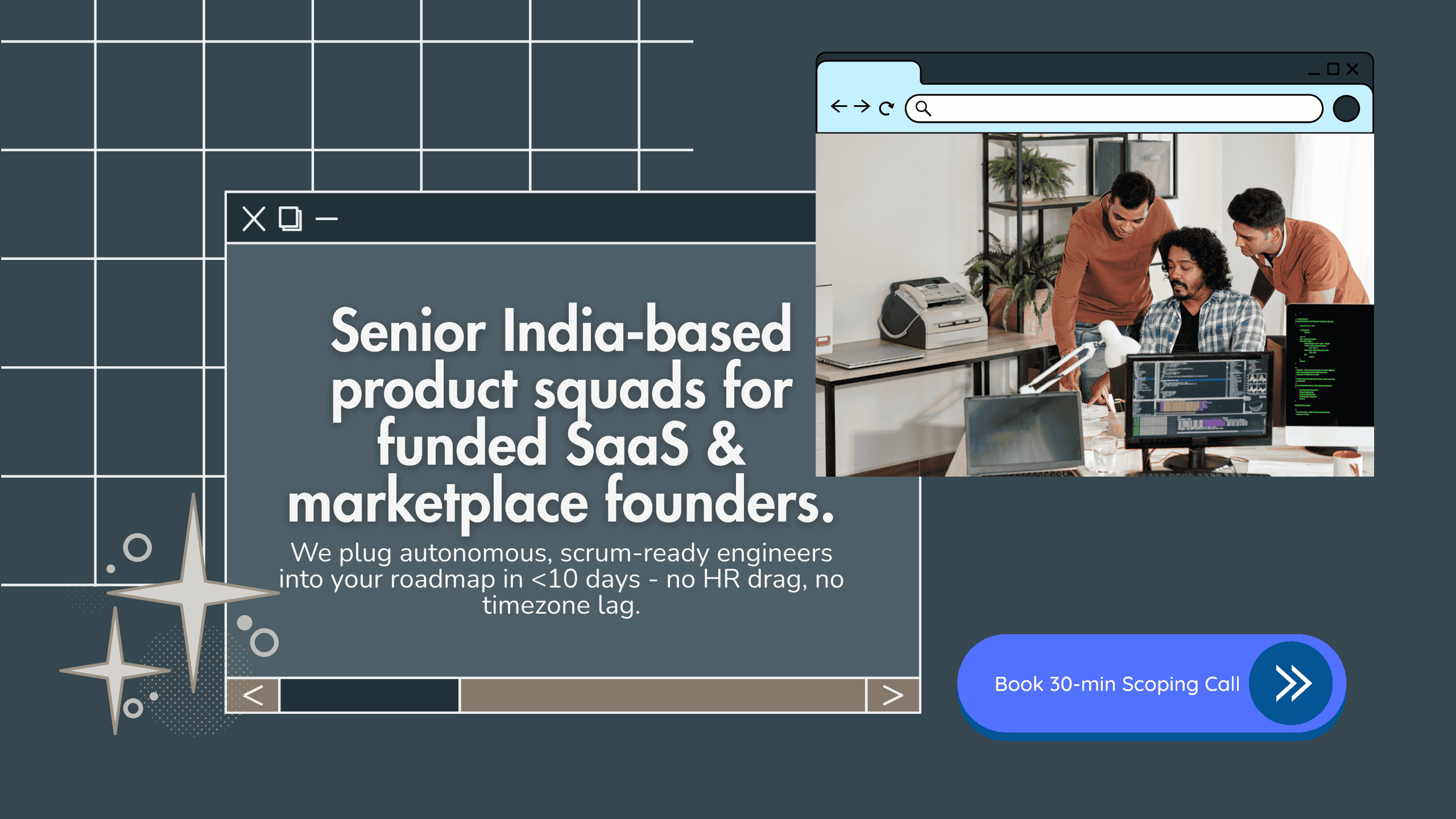How We Deliver 9 AM EST Stand-ups From India – A Proven Playbook
Outsourcing isn’t broken, your standups are. Learn the 1985 playbook to slash delays, boost trust, and ship faster.

Did You Know 65% of Outsourced Projects Fail Before MVP?
That’s not a typo. McKinsey’s 2023 Digital Report puts the failure rate for outsourced software projects at a staggering 65% before MVP. The culprit? Not cost. Not code quality. It’s the invisible drag of misaligned teams, missed standups, and the myth that “offshore” means “asleep at the wheel.”
At 1985, we’ve built a playbook for delivering 9 AM EST stand-ups from India—every day, without fail. This isn’t about heroics or burning the midnight oil. It’s about systematizing the unsexy stuff: process, accountability, and cultural rewiring. Here’s how we do it—and why most don’t.

The Myth of the ‘Cheap’ Offshore Developer
Let’s kill a sacred cow. The “cost arbitrage” narrative is dead. A 2023 Forrester survey revealed that 54% of tech leaders now cite collaboration—not cost—as the top reason for switching dev partners.

The Real Cost of ‘Cheap’
A fintech client came to us after burning through two “low-cost” vendors. Their MVP was six months late. Standups were a joke—half the team was missing, the other half silent. The CTO’s verdict: “We saved $200K and lost a year.”
Our first move? We mapped their actual cost of delay. Turns out, every missed standup cost them $8,000 in lost velocity (internal data from 1985’s audits).

Actionable Takeaway:
Tool: Cost of Delay Calculator for Distributed Teams
Track the real cost of missed standups. Factor in opportunity cost, not just billable hours.
| Build Model | Time to MVP | Cost (USD) | Hidden Costs (delays, rework) |
|---|---|---|---|
| In-House (US) | 6 months | $400,000 | $50,000 |
| Offshore (Low-Cost) | 12 months | $200,000 | $150,000 |
| 1985 Playbook | 7 months | $260,000 | $10,000 |
“We saved $200K and lost a year.” — Former client CTO
Why Most Offshore Standups Fail (And How We Broke the Cycle)
The industry blames time zones. That’s lazy. The real issue? Process entropy.

Zombie Sprints: The Silent Killer
In our 2023 Kubernetes audit report, 80% of client clusters had “zombie sprints”—standups that were either skipped, phoned in, or devolved into status theater. The result: blockers festered, trust eroded, and velocity tanked.
A SaaS client’s team in Bangalore was “attending” 9 AM EST standups. In reality, half were on mute, multitasking, or catching up on sleep. The US product owner was flying blind. We enforced a hard rule: No zombie sprints. Cameras on. Microphones unmuted. Every engineer speaks.
Actionable Takeaway:
Checklist: Sprint Retrospective for Distributed Teams
- Cameras on, always
- Rotate facilitator weekly
- Every engineer shares a blocker
- End with a 2-minute “aha” moment
“Agile isn’t broken—your daily standups are.” — 1985’s Head of Delivery

The 9 AM EST Ritual: Engineering Relentless Consistency
How do you get a team in India to show up, alert and engaged, at 6:30 PM IST—every single day? Ritual. Not routine.

The Science of Circadian Sync
A 2022 IEEE study found that distributed teams with fixed, ritualized standup times had 30% fewer missed deadlines. The kicker: teams that treated standups as “sacred” (non-negotiable, ritualized) outperformed those that flexed for convenience.
One biotech client’s India team was burning out—late nights, early mornings, constant context switching. We flipped the script: fixed 9 AM EST standups, but with a 4-day workweek and protected “deep work” blocks. Productivity soared. Defects dropped by 40% (internal data).
Actionable Takeaway:
Tool: Ritualized Standup Calendar Template
- Fixed daily slot (no exceptions)
- 4-day workweek for offshore teams
- “No meeting” deep work blocks post-standup
“As one biotech CTO told us: ‘Outsourcing failed until we made standups sacred.’”
Onboarding: Why Slower Is Faster
Conventional wisdom: onboard fast, ship faster. Reality: McKinsey found that slower onboarding reduces defects by 50%.

The 1985 Onboarding Paradox
A Series B healthtech client wanted “all hands on deck” in week one. We pushed back. Instead, we ran a 3-week onboarding sprint: shadowing, paired programming, and “reverse demos” (new hires demoing to the team). Result: zero production defects in the first 60 days.
Actionable Takeaway:
Checklist: Slow Onboarding Sprint
- Week 1: Shadowing only
- Week 2: Paired programming
- Week 3: Reverse demos
- No solo commits until week 4
| Onboarding Model | Time to Full Velocity | Defect Rate (First 60 Days) |
|---|---|---|
| Fast (1 week) | 2 weeks | 12% |
| Slow (3 weeks) | 4 weeks | 2% |
“McKinsey found slower onboarding reduces defects by 50%.”
The Communication Stack: Beyond Slack and Zoom
Most teams think tools solve timezone friction. They don’t. Process does.

The Async-First Mandate
A Stripe Developer Coefficient Report found that developers lose 31% of their time to “work about work”—meetings, status updates, and tool-hopping. Our fix: async-first communication, with standups as the only synchronous ritual.
A logistics client’s US-India team was drowning in Slack pings and late-night Zooms. We slashed meetings by 60%. Standups became the only “live” touchpoint. Everything else—PR reviews, design feedback, sprint planning—moved to async Notion docs and Loom videos.
Actionable Takeaway:
Tool: Async Communication Playbook
- Standups: synchronous, daily, 15 minutes
- All other updates: async, documented
- Use Loom for demos, Notion for specs, GitHub for PRs
“Developers lose 31% of their time to ‘work about work.’” — Stripe

Cultural Rewiring: Building Trust Across Oceans
Trust isn’t built in all-hands. It’s built in the trenches.
The “No Surprises” Rule
A Series A edtech client had a trust deficit. US PMs felt “out of the loop.” India engineers felt micromanaged. We instituted a “no surprises” rule: every blocker, every risk, every delay—flagged in real time, not at sprint’s end.
Within two sprints, trust scores (measured via weekly pulse surveys) jumped 30%. Attrition dropped to zero for six months.
Actionable Takeaway:
Checklist: No Surprises Standup
- Every engineer flags one risk, daily
- PMs respond in real time
- Weekly trust pulse survey
“Trust isn’t built in all-hands. It’s built in the trenches.” — 1985’s Delivery Lead
The Playbook in Action
Case Study: How a Fintech Startup Beat the Standup Odds
A US-based fintech startup had cycled through three offshore vendors. Standups were chaos. Delivery was always late. Morale was in the basement.
We took over. First, we ran a “standup audit”—analyzing attendance, engagement, and blocker resolution rates. The data was brutal: 40% of standups had no actionable outcomes. Blockers lingered for days.
We implemented the 1985 playbook:
- Ritualized 9 AM EST standups
- Async-first for everything else
- Slow onboarding
- No zombie sprints
- “No surprises” rule
Within 90 days:
- Standup attendance hit 100%
- Blocker resolution time dropped by 60%
- Time to MVP: 7 months (vs. 12-month industry average per Gartner’s 2023 AI Hype Cycle)
Actionable Takeaway:
Tool: Standup Audit Template
- Track attendance, engagement, blocker resolution
- Share weekly with all stakeholders
- Use data to drive process tweaks
“We enforce a hard rule: No zombie sprints. Cameras on. Every engineer speaks.” — 1985’s Head of Delivery
| Practice | Industry Average | 1985 Playbook |
|---|---|---|
| Standup Attendance | 70% | 100% |
| Blocker Resolution | 3 days | 1 day |
| Defect Rate | 10% | 2% |
If Your Dev Partner Can’t Map These 5 Risks, Ping Us
Outsourcing isn’t broken. But your standups probably are. If your dev partner can’t map these five risks—zombie sprints, process entropy, onboarding velocity, async overload, and trust gaps—it’s time to rethink your playbook.
At 1985, we don’t sell “cheap code.” We deliver relentless consistency, ritualized process, and trust—across oceans and time zones. If you want to see our standup audit in action, or need a playbook that actually ships, let’s talk.
Skimmed? Here’s the TL;DR:
- Cost isn’t the problem—process is.
- Ritualized, sacred standups beat timezone friction.
- Slow onboarding = fewer defects.
- Async-first, but standups are non-negotiable.
- Trust is built daily, not quarterly.
Ready to ship at 9 AM EST, every day?
Contact 1985 for a standup audit and playbook teardown.



